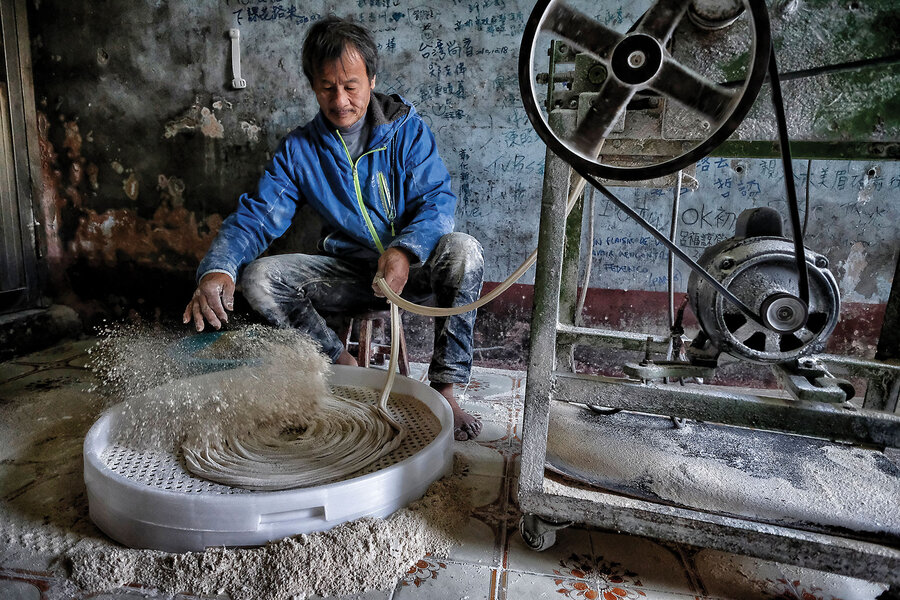
In one small room of their home, Lin Zheng Yi kneads noodle dough by hand, and in another, his wife, Liao Li Mei, rolls a different batch onto two bamboo poles attached to a wall. The dough will stretch there before being hung out in the sun to dry like laundry – part of a centuries-old process that has been passed down through generations.
“Most people now make the noodles by machine,” Mr. Lin says. “But we will continue the tradition until we retire.”
Why We Wrote This
In Taiwan, making wheat vermicelli mostly by hand is a dying tradition. Here’s one family that is still following the centuries-old process passed down through generations.
The couple and Mr. Lin’s mother, who live in Fuxing on Taiwan’s western coast, are one of the last families on the island to prepare misua – a wheat vermicelli – mostly by hand. They use the same method that migrants from China’s Fujian province brought with them in the 17th century. As Ms. Liao explains, these long, extra-thin noodles – made only from wheat flour, water, and salt – used to be “eaten on holidays or to celebrate birthdays as a symbol of longevity, but nowadays they are eaten every day.”
Mr. Lin says he is glad that his children will be dedicating themselves to other ways of making a living. Still, he explains, “I am sad to lose the trade I learned from my father and grandfather.”
They work barefoot all morning, each so intently that they hardly ever speak. In one small room of their home, Lin Zheng Yi kneads noodle dough by hand, and in another, his wife, Liao Li Mei, rolls a different batch onto two bamboo poles attached to a wall. The dough will stretch there before being hung out in the sun to dry like laundry – part of a centuries-old process that has been passed down through generations.
“Most people now make the noodles by machine,” Mr. Lin says. “But we will continue the tradition until we retire.”
The couple and Mr. Lin’s mother, who live in Fuxing on Taiwan’s western coast, are one of the last families on the island to prepare misua – a wheat vermicelli – mostly by hand. They use the same method that migrants from China’s Fujian province brought with them in the 17th century. As Ms. Liao explains, these long, extra-thin noodles – made only from wheat flour, water, and salt – used to be “eaten on holidays or to celebrate birthdays as a symbol of longevity, but nowadays they are eaten every day.”
The work starts daily by 5 a.m., beginning with the kneading and stretching. At midmorning, the couple take what they’ve prepared out to their courtyard, which soon becomes covered with noodles resembling giant hammocks made of fine threads, about 3 millimeters (one-tenth of an inch) thick and 5 meters (16 feet) long. The next step is to fold the noodles in half and hang them vertically, turning the hammocks into curtains 2 meters long. The following morning, the noodles cook for six hours in a wood-fired oven before they can be cut and packed for sale.
The couple’s grown children are not interested in continuing the long family tradition.
Gazing proudly at his daughter, Mr. Lin says he is glad that his children are dedicating themselves to other ways of making a living. Still, he explains, “I am sad to lose the trade I learned from my father and grandfather.”




